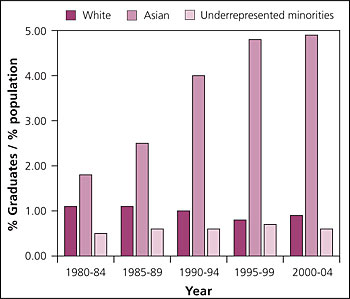
Am Fam Physician. 2007;76(1):38
The racial/ethnic composition of U.S. medical schools does not reflect the U.S. population. With proper planning, the current medical school expansion could improve physician diversity and reduce health disparities.
The Council on Graduate Medical Education (COGME) asserts that “the racial/ethnic composition of the physician population should reflect the overall population's diversity.”1 Blacks, Hispanics, and Native Americans make up 26 percent of the U.S. population, but only 6 percent of practicing physicians come from these underrepresented minorities.2 Underrepresented minorities experience worse health status in many dimensions compared with the white population, and COGME states that: “Increasing the percentage of minorities in the medical profession is vital as a means of improving access to care and health status of these vulnerable and underserved populations.”3 Underrepresented minority medical graduates are more likely to become primary care physicians4 and to care for minorities and other underserved people.
Since the end of the last allopathic medical school expansion (1980), the percentage of U.S. medical graduates who are Asian American has risen from almost two times to almost five times the percentage of Asian Americans in the U.S. population. The percentage of under-represented minority medical graduates has remained at about one half that of underrepresented minorities in the U.S. population (see accompanying figure).5–7

Failing to increase minority representation in medicine risks exacerbating health disparities, because minority populations are growing much faster than the population as a whole.
An expansion of allopathic and osteopathic medical schools is under way, with calls to increase allopathic enrollment 15 to 30 percent by 2015. This expansion offers an immediate opportunity to produce a physician workforce more representative of underserved populations through race-conscious medical school admissions, increased financial support for underrepresented students, and increased academic enrichment for minority students.